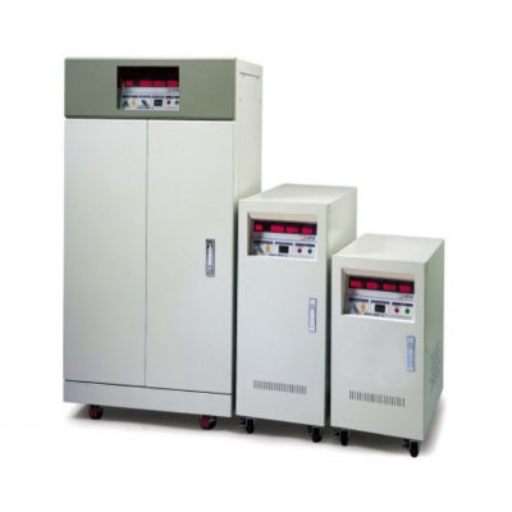In today’s interconnected electrical infrastructure, the ability to adapt power systems across different regions and applications has become a critical engineering objective. One such device that enables this flexibility is the AC power frequency converter, which ensures equipment functionality regardless of regional power supply standards and specific operating conditions. Whether you need to adapt industrial machines for international systems, optimize power efficiency, or extend equipment service life, understanding these converters is essential.
Key Takeaway: AC power frequency converters are transforming traditional power systems into efficient, adaptable machines necessary for today’s globalized world.
What is an AC Power Frequency Converter?

An AC power frequency converter modifies the frequency of AC power to meet the specific requirements of particular devices or systems. These sophisticated devices achieve this through a two-stage process:
- Rectification: Converting input AC power to DC power using advanced rectifier circuits
- Inversion: Converting DC power back to AC at the desired frequency using modern inverter technology
This process enables equipment to operate optimally even when facing variations in geographic power supplies and specific application requirements.
How AC-AC Frequency Converters Work
The Two-Stage Conversion Process
Rectifying
AC input is converted to DC, eliminating frequency dependency
Inverting
DC power is converted back to AC at the desired frequency using IGBT technology
Modern frequency converters utilize Pulse Width Modulation (PWM) techniques to create clean sine wave outputs with minimal harmonic distortion and reduced energy losses. Advanced control algorithms ensure stable, precise operation across varying load conditions.
Market Growth: The global frequency converter market is expected to grow at over 6% CAGR from 2023 through 2030, driven by energy efficiency requirements and automation demands.
Understanding Power Frequencies: 50Hz, 60Hz, and 400Hz
| Frequency | Primary Regions | Applications | Characteristics |
|---|---|---|---|
| 50Hz | Europe, Asia, Africa | Industrial, residential power | Larger transformers and motors |
| 60Hz | North America, parts of South America | Industrial, residential power | More compact equipment design |
| 400Hz | Aviation, military, specialized | Aircraft, ships, precision equipment | Lightweight, compact power systems |
Why 400Hz for Specialized Applications?
The higher frequency of 400Hz provides several advantages for aviation and military applications:
- Weight Reduction: Smaller transformers and generators
- Space Efficiency: Compact power systems ideal for aircraft and spacecraft
- Enhanced Performance: Better efficiency in specialized equipment
Key Functions and Benefits
| Function | Description | Benefit |
|---|---|---|
| Frequency Conversion | Changes AC frequency for specific applications | Equipment compatibility across regions |
| Voltage Adjustment | Modifies voltage levels for compatibility | Protects equipment from voltage mismatches |
| Motor Speed Control | Precisely controls motor speed and torque | Energy savings up to 40% in HVAC systems |
| Soft-Start Capability | Gradually starts motors | Reduces mechanical wear and tear |
| Power Factor Correction | Improves power quality | Reduces energy losses and costs |
Practical Example: Converting 110V 60Hz to 220V 50Hz

Conversion Process
Step 1: 110V 60Hz input → DC conversion via controlled rectifier
Step 2: DC power conditioning and voltage adjustment
Step 3: DC → 220V 50Hz AC via advanced inverter technology
Efficiency: Modern converters achieve 95-98% efficiency
Static vs. Rotary Frequency Converters
| Aspect | Static Converter | Rotary Converter |
|---|---|---|
| Mechanism | Solid-state electronics, no moving parts | Motor-generator combination |
| Best Applications | Small-scale, low-power (<5 kVA) | Large-scale, high-power (>10 kVA) |
| Efficiency | High across all sizes | Varies, better with heavy loads |
| Maintenance | Minimal, no moving parts | Regular maintenance required |
| Noise Level | Quiet operation | Audible noise during operation |
| Installation | Easy and quick | Complex and labor-intensive |
Pure Sine Wave Technology
Pure sine wave frequency converters represent the pinnacle of power conversion technology, producing clean, utility-grade power output. These advanced systems are essential for:
- Medical Equipment: Hospital machines requiring precise power quality
- Audio Equipment: Professional sound systems and sensitive electronics
- Industrial Machinery: Precision manufacturing equipment
- Renewable Energy: Solar and wind power integration
Market Value: The global pure sine wave frequency converter market reached $500 million in 2023, with significant growth in renewable energy, aviation, and medical sectors.
Industry Applications

Manufacturing and Industrial
- Conveyor belt systems and assembly lines
- Robotic manufacturing equipment
- CNC machines and precision tools
- Welding equipment and industrial motors
Renewable Energy Integration
- Wind turbine power conditioning
- Solar inverter systems
- Grid synchronization and power quality improvement
- Energy storage system integration
Aviation and Military (400Hz Systems)
- Aircraft Power Systems: Instrumentation, lighting, and communication equipment
- Ground Power Units (GPU): Airport ground support equipment
- Naval Applications: Shipboard navigation and weapon systems
- Combat Vehicles: Radar and telecommunications equipment
- Aerospace: Spacecraft propulsion and communication systems
Commercial and Residential
- HVAC Systems: Energy-efficient motor control
- Elevators and Escalators: Smooth operation and energy savings
- Lighting Systems: Consistent power supply and reduced flickering
- Home Appliances: Washing machines, air conditioners, refrigerators
Energy Efficiency and Cost Benefits
Energy reduction in HVAC systems with frequency converters
Power usage reduction with Variable Speed Drives (VSDs)
Increase in motor longevity with proper frequency control
Reduction in maintenance expenses
Choosing the Right Frequency Converter

Key Selection Criteria
| Factor | Consideration | Impact |
|---|---|---|
| Input Voltage | Match power source voltage level | Prevents overload and damage |
| Phase Configuration | Single-phase vs. three-phase | Determines application suitability |
| Power Rating (kVA) | Match load requirements | Ensures adequate power handling |
| Frequency Range | Input and output frequency compatibility | Enables proper equipment operation |
| Protection Features | Overvoltage and overcurrent protection | Long-term equipment safety |
KVA Ratings: Single Phase vs. Three Phase
| Aspect | Single Phase | Three Phase |
|---|---|---|
| Formula | Voltage × Current ÷ 1,000 | Voltage × Current × 1.732 ÷ 1,000 |
| Applications | Residential, small commercial | Industrial, large commercial |
| Standard Sizes | 1, 5, 10, 25, 50, 100 kVA | 3, 15, 30, 75, 150, 300 kVA |
| Efficiency | Lower for high power loads | Higher for high power loads |
| Common Uses | Lighting, small appliances | Motors, heavy machinery |
5 KVA Single Phase 230V Applications
A 5 KVA single-phase 230V frequency converter serves multiple purposes across various sectors:
Industrial Machinery
CNC machines, welding units, and small motors in workshops
Commercial Installations
Lighting, refrigeration, and HVAC systems in shops and offices
IT Equipment
Servers, routers, and critical infrastructure in small offices
Renewable Energy
Solar inverters and power storage conditioning
Technical Specifications
- Power Output: 5,000 watts capacity
- Efficiency: >95% in modern units
- Motor Capacity: Can handle 2 HP motor (~1.5 kVA) with room for additional devices
- Voltage Standard: Designed for 230V regions (Europe, Asia, and other markets)
Latest Technological Advancements

Semiconductor Innovations
- Silicon Carbide (SiC): Reduced energy losses and higher operating temperatures
- Gallium Nitride (GaN): Enhanced efficiency and compact designs
- Advanced IGBTs: Improved switching performance and reliability
Smart Control Systems
- IoT Integration: Real-time monitoring and remote diagnostics
- AI-Based Control: Predictive maintenance and optimization
- Cloud Connectivity: Enhanced system management and analytics
Future Market Trends
Growth Projection: The frequency converter market is expected to grow at 7.5% CAGR from 2023-2030, driven by industrial automation, renewable energy, and electric vehicle adoption.
Key Growth Drivers
- Renewable Energy Expansion: Wind and solar power integration
- Electric Vehicle Infrastructure: EV charging systems and powertrain optimization
- Industrial Automation: Process efficiency and energy conservation
- Smart Grid Development: Grid stability and power quality improvement
References
-
Power Electronics Based Voltage and Frequency Controller
This paper discusses voltage and frequency controllers in applications like stand-alone wind energy systems.
Read the paper here -
Multi-Frequency Modulation and Control for DC/AC and AC/DC Resonant Converters
A dissertation exploring modulation and control techniques for resonant converters.
Read the dissertation here -
An AC-AC High Frequency Pulse Density Modulated Full Bridge Series Resonant Converter
This paper focuses on a new AC-AC converter design for induction heating applications.
Read the paper here
Frequently Asked Questions
An AC power frequency converter transforms AC power from one frequency to another, enabling equipment designed for specific frequencies (like 50Hz to 60Hz) to operate in different regional power systems.
Frequency converters use semiconductor technology to first convert AC input to DC, then invert it back to AC at the desired frequency and voltage, maintaining power quality throughout the process.
This conversion is essential for operating industrial machinery, aviation equipment, and other devices at their specified frequency in countries with different power standards, preventing equipment damage and ensuring optimal performance.
Single-phase converters are suitable for residential and small commercial applications, while three-phase converters are designed for industrial applications with higher power requirements and better load balancing.
Yes, a frequency converter can handle both voltage and frequency conversion, enabling 240V 50Hz equipment to operate safely on 120V 60Hz power systems commonly found in North America.
Conclusion
AC power frequency converters have become indispensable in our interconnected world, enabling seamless operation of equipment across different power standards and applications. From industrial automation to renewable energy integration, these devices continue to evolve with advancing semiconductor technology, smart control systems, and environmental consciousness.
As we move toward a more sustainable and automated future, frequency converters will play an increasingly vital role in optimizing energy efficiency, reducing operational costs, and enabling global equipment compatibility. Whether you’re selecting a converter for industrial applications, renewable energy systems, or specialized military/aviation use, understanding these technologies ensures optimal performance and long-term reliability.
